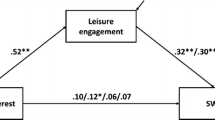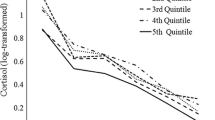Abstract
The aim of the current study was to examine the role of satisfaction-with-event as a mediator in the relations between flow and life satisfaction based on the bottom-up theory (Andrews and Withey in Social indicators of well-being: Americans’ perceptions of life quality. Plenum, New York, 1976; Lee et al. in J Macromarketing 22(2): 158–169, 2002). Four hundred and thirty-four participants with a mean age of 35.60 (SD = 11.76) were recruited from the audience of a “Cirque du Soleil” acrobatics show, performed in Taiwan in 2009. Participants completed the flow scale (Csikszentmihalyi in Flow: the psychology of optimal experience. Harper & Row, New York, 1990), a satisfaction-with-event scale (Lin and Hsu in Mark Rev 3(4): 497–528, 2008), and a satisfaction-with-life scale (Diener et al. in J Pers Assess 49:71–75, 1985) immediately after viewing the show. Structural equation modeling was conducted to examine our hypothesis that satisfaction-with-event levels would fully mediate the relationship between flow and overall life satisfaction. Results supported our prediction and are discussed in terms of bottom-up theory. Implications of the study are also provided for the leisure managers.



Similar content being viewed by others
References
Andrews, F. M., & Withey, S. B. (1976). Social indicators of well-being: Americans’ perceptions of life quality. New York: Plenum.
Asakawa, K. (2004). Flow experience and autotelic personality in Japanese college students: How do they experience challenges in daily life? Journal of Happiness Studies, 5, 123–154.
Bagozzi, R., & Yi, Y. (1988). On the evaluation of structural equation models. Journal of the Academy of Marketing Science, 16(1), 74–94.
Barclay, D. W., Thompson, R., & Higgins, C. A. (1995). The partial least squares (PLS) approach to causal modeling: Personal computer adoption and use as an illustration. Journal of Technology Studies, 2(2), 285–309.
Brief, A. P., Butcher, A. H., George, J. M., & Link, K. E. (1993). Integrating bottom-up and top-down theories of subjective well-being: The case of health. Journal of Personality and Social Psychology, 64(4), 646–653.
Bryant, R. M., & Constantine, M. G. (2006). Multiple role balance, job satisfaction, and life satisfaction in women school counselors. Professional School Counseling, 9(4), 265–271.
Chang, L.-C. (2003). Relationship among demographic variables, flow experience, leisure satisfaction and life satisfaction of elder adults in nursing Home Unpublished master’s thesis. National Dong Hwa University, Hualien, Taiwan.
Chen, L. H., & Kee, Y. H. (2008). Gratitude and adolescent athletes’ well-being. Social Indicators Research, 89(2), 361–373.
Chen, L. H., Tsai, Y. M., & Chen, M. Y. (2010). Psychometric analysis of the orientations to happiness questionnaire in Taiwanese undergraduate students. Social Indicators Research (in press).
Csikszentmihalyi, M. (1990). Flow: The psychology of optimal experience. New York: Harper & Row.
Csikszentmihalyi, M. (1996). Creativity: Flow and the psychology of discovery and invention (1st ed.). New York: Harper Collins.
Csikszentmihalyi, M. (2000). Beyond boredom and anxiety. San Francisco: Jossey-Bass.
Csikszentmihalyi, M., & Robinson, R. E. (1990). The art of seeing: An interpretation of the aesthetic encounter. Malibu, CA; Los Angeles. CA: J.P. Getty Museum; Getty Center for Education in the Arts.
Diener, E., Emmons, R. A., Larsen, R. J., & Griffin, S. (1985). The satisfaction with life scale. Journal of Personality Assessment, 49, 71–75.
Headey, B., Veenhoven, R., & Wearing, A. (1991). Top-down versus bottom-up theories of subjective well-being. Social Indicators Research, 24(1), 81–100.
Heller, D., Perunovic, W. Q. E., & Reichman, D. (2009). The future of person-situation integration in the interface between traits and goals: A bottom-up framework. Journal of Research in Personality, 43(2), 171–178.
Hu, L., & Bentler, P. M. (1999). Cutoff criteria for fit indexes in covariance structure analysis: Conventional criteria versus new alternatives. Structural Equation Modeling, 6, 1–55.
Huang, C.-Y., & Carleton, B. (2003). The relationships among leisure participation, leisure satisfaction, and life satisfaction of college students in Taiwan. Journal of Exercise Science and Fitness, 1(2), 129–132.
Jackson, S. A., Martin, A. J., & Eklund, R. C. (2008). Long and short measures of flow: The construct validity of the FSS-2, DFS-2, and new brief counterparts. Journal of Sport & Exercise Psychology, 30, 561–587.
Jones, C. D., Hollenhorst, S. J., Perna, F., & Selin, S. (2000). Validation of the flow theory in an on-site whitewater kayaking setting. Journal of Leisure Research, 32(2), 247–261.
Kaplanidou, K., & Vogt, C. (2007). The interrelationship between sport event and destination image and sport tourists’ behaviours. Journal of Sport & Tourism, 12(3/4), 183–206.
Lance, C. E., Lautenschlage, G. J., Sloan, C. E., & Varca, P. E. (1989). A comparison between bottom-up, top-down, and bidirectional models of relationships between global and life facet satisfaction. Journal of Personality, 57(3), 601–624.
Lee, D. J., Sirgy, M. J., Larsen, V., & Wright, N. D. (2002). Developing a subjective measure of consumer well-being. Journal of Macromarketing, 22(2), 158–169.
Leonardi, F., Spazzafumo, L., & Marcellini, F. (2005). Subjective well-being: The constructionist point of view. A longitudinal study to verify the predictive power of top-down effects and bottom-up processes. Social Indicators Research, 70(1), 53–77.
Leonardi, F., Spazzafumo, L., Marcellini, F., & Gagliardi, C. (1999). The top-down/bottom-up controversy from a constructionist approach: A method for measuring top-down effects applied to a sample of older people. Social Indicators Research, 48(2), 189–218.
Lin, L. Y., & Hsu, T. W. (2008). A study on the relationship between performance quality, service quality, customer satisfaction and customer loyalty. Marketing Review, 3(4), 497–528.
Lindell, M. K., & Whitney, D. J. (2001). Accounting for common method variance in cross-sectional research designs. Journal of Applied Psychology, 86(1), 114–121.
MacCallum, R., Browne, M. W., & Sugawara, H. M. (1996). Power analysis and determination of sample size for covariance structure modeling. Psychological Methods, 1(2), 130–149.
Marsh, H. W. (1989). Confirmatory factor analyses of multitrait-multimethod data: Many problems and a few solutions. Applied Psychological Measurement, 13(4), 335–361.
Mossholder, K. W., Bennet, N., Kemery, E. R., & Wesolowski, M. A. (1998). Relationships between bases of power and work reactions: The mediational role of procedural justice. Journal of Management, 24(4), 533–552.
Nakamura, J., & Csikszentmihalyi, M. (2002). The concept of flow. In C. R. Snyder & S. J. Lopez (Eds.), Handbook of positive psychology (p. xviii, 829 p). Oxford: Oxford University Press.
Peterson, C., Park, N., & Seligman, M. E. P. (2005). Orientations to happiness and life satisfaction: The full life versus the empty life. Journal of Happiness Studies, 6(1), 25–41.
Peterson, C., Ruch, W., Beermann, U., Park, N., & Seligman, M. E. P. (2007). Strengths of character, orientations to happiness, and life satisfaction. The Journal of Positive Psychology, 2, 149–156.
Rice, R. W., Near, J. P., & Hunt, R. G. (1980). The job-satisfaction/life-satisfaction relationship: A review of empirical research. Basic and Applied Social Psychology, 1(1), 37–64.
Rich, G. J. (2001). Positive psychology: An introduction. Journal of Humanistic Psychology, 41(1), 8–12.
Rode, J., Rehg, M., Near, J., & Underhill, J. (2007). The effect of work/family conflict on intention to quit: The mediating roles of job and life satisfaction. Applied Research in Quality of Life, 2(2), 65–82.
Ryan, R. M., & Deci, E. L. (2000). Self-determination theory and the facilitation of intrinsic motivation, social development, and well-being. American Psychologist, 55, 68–78.
Scherpenzeel, A., & Saris, W. (1996). Causal direction in a model of life satisfaction: The top-down/bottom-up controversy. Social Indicators Research, 38(2), 161–180.
Seligman, M. E. P., & Csikszentmihalyi, M. (2000). Positive psychology: An introduction. American Psychologist, 55(1), 5–15.
Sheldon, K. M., & King, L. (2001). Why positive psychology is necessary. American Psychologist, 56(3), 216–217.
Tokar, D. M., & Jome, L. M. (1998). Masculinity, vocational interests, and career choice traditionality: Evidence for a fully mediated model. Journal of Counseling Psychology, 45(4), 424–435.
Vella-Brodrick, D., Park, N., & Peterson, C. (2009). Three ways to be happy: Pleasure, engagement, and meaning—Findings from Australian and US samples. Social Indicators Research, 90(2), 165–179.
Wu, C. H. (2008). The role of perceived discrepancy in satisfaction evaluation. Social Indicators Research, 88, 423–436.
Wu, C. H., Chen, L. H., & Tsai, Y. M. (2009a). Investigating important weighting of satisfaction score from formative model with partial least squares analysis. Social Indicators Research, 90, 351–363.
Wu, C. H., Chen, L. H., & Tsai, Y. M. (2009b). Longitudinal invariance analysis of the satisfaction with life scale. Personality and Individual Differences, 46, 396–401.
Wu, C. H., & Yao, G. (2006). Analysis of factorial invariance across gender in the Taiwan version of the satisfaction with life scale. Personality and Individual Differences, 40(6), 1259–1268.
Wu, C. H., & Yao, G. (2008). Psychometric analysis of the short-form UCLA loneliness scale (ULS-8) in Taiwanese undergraduate students. Personality and Individual Differences, 44, 1762–1771.
Acknowledgments
This study was partially supported by a grant form the National Science Council (NSC98-2410-H179-005) to Mei-Yen Chen. We are also grateful for the anonymous reviewer’s insightful comments for our manuscript.
Author information
Authors and Affiliations
Corresponding author
Rights and permissions
About this article
Cite this article
Chen, L.H., Ye, YC., Chen, MY. et al. Alegría! Flow in Leisure and Life Satisfaction: The Mediating Role of Event Satisfaction Using Data from an Acrobatics Show. Soc Indic Res 99, 301–313 (2010). https://doi.org/10.1007/s11205-010-9581-z
Accepted:
Published:
Issue Date:
DOI: https://doi.org/10.1007/s11205-010-9581-z




